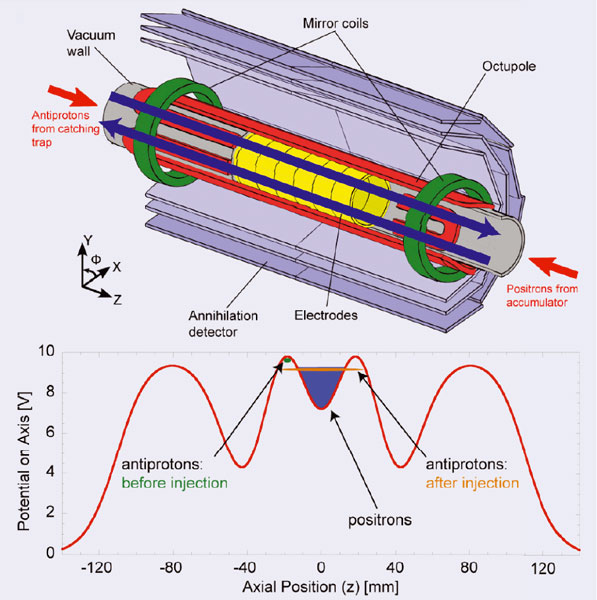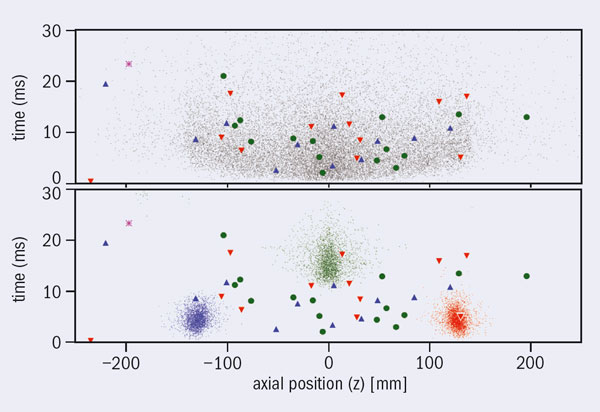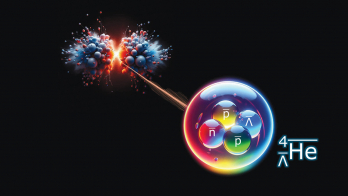Jeffrey Hangst reports on the first magnetic trapping of antihydrogen.

On 17 November 2010 the ALPHA collaboration at CERN’s Antiproton Decelerator (AD) reported online in the journal Nature that they had observed trapped antihydrogen atoms by releasing them quickly from the magnetic trap in which they were produced and detecting the annihilation of the antiproton – the nucleus of the antihydrogen atom (Andresen et al. 2010a). This exciting result from a proof-of-principle experiment paves the way to detailed study of antimatter atoms.
Do matter and antimatter obey the same laws of physics? One intriguing way to test this would be to compare the spectra of hydrogen and its antimatter twin: antihydrogen. Such studies would build on almost a century of detailed theoretical and experimental investigation of the hydrogen atom, from the Bohr model to the ultraprecise measurements of Nobel laureate Theodor Hänsch and colleagues. The frequency of the 1s–2s transition in hydrogen has been measured with a precision of about 2 parts in 1014. The CPT theorem requires that this frequency must be exactly the same in antihydrogen. The goal of the ALPHA experiment is to test this claim – at least from the high-energy physics point of view. To the atomic physicist, for whom hydrogen is the basic, elegant workhorse of the evolution of quantum mechanics, the question is perhaps: “How could you possibly have access to antihydrogen and not try to measure that?”

Image credit: P Pusa, ALPHA/University of Liverpool.
While our colleagues at the LHC have been busily setting new records for the highest energy stored hadrons, we at the AD have been headed in the other direction – setting a new record for the lowest energy anti-hadrons. The antihydrogen atoms in ALPHA can be trapped only if their kinetic energy, in temperature units, is less than 0.5 K. This corresponds to about 9 × 10–5 eV, or 3 × 10–17 times the energy of protons in the LHC, which represents quite a dynamic range for CERN.
The low temperature necessary has been a daunting challenge for the ALPHA experimenters. Antihydrogen is formed by mixing antiprotons from the AD with positrons from a special accumulator fuelled by a 22Na positron emitter. The particles are mixed in cryogenic Penning traps, which feature strong solenoidal magnetic fields for transverse confinement and electrostatic fields for longitudinal confinement (figure 1). The resultant antihydrogen, which is electrically neutral, can be confined only by the weak interaction of its magnetic dipole moment with an external magnetic trapping-field. The strength of this dipole interaction is such that, for ground state antihydrogen, a 1 T deep magnetic well can confine atoms with kinetic energy up to 0.7 K.
The atom trap in ALPHA comprises an octupole magnet and two solenoidal “mirror coils” (figure 1). These produce a magnetic minimum at the position at which the antihydrogen atoms are formed. If the atoms are formed with a kinetic energy of less than about 0.5 K (in temperature units), they are trapped. (This is for the ground state; excited atoms can have a larger magnetic moment and experience a deeper well.)
The difficulty lies in the transition from plasmas of charged particles to neutral atoms. The space-charge potential energies in the plasmas can be of order 10 eV – about 120 000 K in temperature equivalent. So one of the experimental challenges for antihydrogen trapping has been to learn how to cool and carefully manipulate the charged species to produce cold, trappable atoms.
At ALPHA, we mix about 30 000 antiprotons with about two million positrons in each attempt to trap antihydrogen. The two plasmas are placed in adjacent potential wells, as in figure 1, and the antiprotons are then driven into the positron plasma using a frequency-swept, axial electric field (Andresen et al. 2011). This drive is “autoresonant”, i.e. the amplitude of the antiproton oscillation automatically matches the corresponding drive frequency in the nonlinear potential well. The idea is to control the energy of the antiprotons precisely by carefully tailoring the drive frequencies. The antiprotons enter the positron cloud with low relative energy and do not heat the positron cloud on entry.

The positrons themselves are self-cooling: they lose energy by radiation in the 1 T magnetic field in the Penning trap. We supplement this process using evaporative cooling. Starting with an equilibrated positron plasma in a potential well, we lower one side of the well, allowing the hottest positrons to escape. The remaining positrons re-equilibrate through collisions, settling to a lower temperature. The technique, which is well known in the field of Bose-Einstein condensation for neutral atoms, was also demonstrated by ALPHA on antiprotons in 2009 (Andresen et al. 2010b). After evaporative cooling, the positrons in ALPHA are at about 40 K. Under ALPHA conditions, the antiprotons can enter the positron plasma and come into thermal equilibrium before making antihydrogen. Thus, only a small fraction of the antihydrogen atoms produced will have a kinetic energy equivalent to less than 0.5 K.
Antiprotons and positrons are allowed to interact or “mix” for 1s to produce antihydrogen, after which we remove any charged particles that remain trapped in the potential wells and then ground the electrodes of the Penning trap. The decisive step is to shut down the magnetic atom trap quickly to see if there are any trapped antihydrogen atoms that escape and annihilate on the walls of the device. However, even with the Penning trap’s electric fields turned off, there is still a small chance that antiprotons could be magnetically trapped due to the mirror effect in the strong magnetic field gradients in the atom trap. To eliminate this possibility, we apply pulsed electric fields along the axis of the trap, in alternating directions, so as to kick any stubborn antiprotons out of the trapping volume.
The ALPHA experiment’s superconducting atom-trap magnets, manufactured at Brookhaven National Laboratory, can be turned off with a time constant of about 9 ms. This fast shutdown helps to discriminate between antihydrogen annihilations and cosmic rays.
Antiproton annihilations are detected by an imaging, three-layer silicon vertex detector (see figure 2) that surrounds the cryostat for the traps and magnets. To be absolutely sure that any annihilations observed come from neutral antimatter and not from charged antiprotons, we apply an axial electric “bias” field to the trap while it is shutting off. While antiprotons would be deflected by this field, antihydrogen is not, and we can see the result using the position-sensitive silicon vertex detector. The silicon detector is also extremely useful in topologically rejecting cosmic rays.
The result of many trapping attempts is shown in figure 3, reproduced from the article in Nature. Each trapping attempt takes about 20 minutes of real time. In 335 trapping attempts, we observed 38 annihilations consistent with the controlled release of trapped antihydrogen atoms. The spatial distribution of these annihilations is not consistent with the expected behaviour of charged particles (figure 3). We can conclude that neutral antihydrogen atoms were trapped for at least 172 ms, which is the time it took to eject the charged particles from the trap and to apply the multiple field pulses to ensure the clearing of mirror-trapped antiprotons.
In subsequent experiments, we made good progress on improving the trapping probability and investigated the storage lifetime of antihydrogen atoms in the trap. At holding times up to 1000s, we still see the signal for release of trapped atoms. This is an encouraging result that leads us to be optimistic about the future of spectroscopic studies with trapped antihydrogen.
When the AD starts up again in 2011, we hope to pick up where we left off in 2010. The first step is to continue to improve the trapping probability for produced antihydrogen atoms, by, for example, working on reducing the positron temperature and studying improvements in the mixing manipulations to make colder antihydrogen. As regards the spectrum of antihydrogen, the 1s to 2s laser-frequency transition described above is not the only game in town. Microwaves can interact with antiatoms in the magnetic trap, either with the positron spin (positron spin resonance) or with the antiproton spin (antinuclear magnetic resonance). Paradoxically, using rare atoms of antimatter can offer a detection bonus for such experiments, as a resonant interaction can lead to loss and annihilation of the trapped atom – an event that can be detected with high efficiency. At ALPHA we hope to take the first steps towards microwave spectroscopy – the first resonant look at the inner workings of an antiatom – in 2011. At the same time we will be working on a new atom-trapping device that is optimized for precision measurements with both lasers and microwaves.
Having demonstrated trapping of antihydrogen atoms, the ALPHA collaboration was able to finish off the year by celebrating the honour of being recognized as the Physics Breakthrough of the Year for 2010 by Physics World magazine. We shared this honour with our friends across the wall at the AD in the ASACUSA collaboration, who produced antihydrogen in a new type of device that could lead to in-flight studies of the antiatoms. Finally, the American Physical Society news staff named our trapping of antihydrogen as one of the top ten physics-related news stories of 2010. All in all, 2010 was a vintage year for antimatter at the AD.








